Third-Party Storage Support
Available as of v1.5.0
Harvester now supports provisioning of root volumes and data volumes using external Container Storage Interface (CSI) drivers. This enhancement allows you to select drivers that meet specific requirements, such as performance optimization or seamless integration with existing internal storage solutions.
The Harvester engineering team has validated the following CSI drivers:
- Longhorn V2 Data Engine:
driver.longhorn.io - LVM:
lvm.driver.harvesterhci.io - NFS:
nfs.csi.k8s.io - Rook (RADOS Block Device):
rook-ceph.rbd.csi.ceph.com
These validated CSI drivers have the following capabilities:
| Storage Solution | VM Image | VM Rook Disk | VM Data Disk | Volume Export To VM Image | VM Template Generator | VM Live Migration | VM Snapshot | VM Backup |
|---|---|---|---|---|---|---|---|---|
| Longhorn v2 Data Engine | ✔ | ✔ | ✔ | ✔ | ✔ | ✔ | ✖ | ✖ |
| LVM | ✔ | ✔ | ✔ | ✔ | ✔ | ✖ | ✔ | ✖ |
| NFS | ✔ | ✔ | ✔ | ✔ | ✔ | ✔ | ✖ | ✖ |
| Rook (RBD) | ✔ | ✔ | ✔ | ✔ | ✔ | ✔ | ✔ | ✖ |
Support for third-party storage equates to support for provisioning of root volumes and data volumes using external container storage interface (CSI) drivers. This means that storage vendors can validate their storage appliances with Harvester to ensure greater interoperability.
The Harvester engineering team exclusively validates internally developed storage solutions and select open-source projects. You can find information about enterprise-grade storage solutions that are certified to be compatible with Harvester in the SUSE Rancher Prime documentation, which is accessible through the SUSE Customer Center.
Prerequisites
To enable Harvester to function well, use CSI drivers that support the following capabilities:
- Volume expansion (online resizing)
- Snapshot creation (volume and virtual machine snapshots)
- Cloning (volume and virtual machine clones)
- Usage of Read-Write-Many (RWX) volumes for Live Migration
Create Harvester cluster
Harvester's operating system follows an immutable design, meaning that most OS files revert to their pre-configured state after a reboot. Therefore, you might need to perform additional configurations before installing the Harvester cluster for third-party CSI drivers.
Some CSI drivers require additional persistent paths on the host. You can add these paths to os.persistent_state_paths.
Some CSI drivers require additional software packages on the host. You can install these packages with os.after_install_chroot_commands.
Upgrading Harvester causes the changes to the OS in the after-install-chroot stage to be lost. You must also configure the after-upgrade-chroot to make your changes persistent across an upgrade. Refer to Runtime persistent changes before upgrading Harvester.
Install the CSI driver
After installing the Harvester cluster is complete, refer to How can I access the kubeconfig file of the Harvester cluster? to get the kubeconfig of the cluster.
With the kubeconfig of the Harvester cluster, you can install the third-party CSI drivers into the cluster by following the installation instructions for each CSI driver. You must also refer to the CSI driver documentation to create the StorageClass and VolumeSnapshotClass in the Harvester cluster.
Configure Harvester Cluster
Before you can make use of Harvester's Backup & Snapshot features, you need to set up some essential configurations through the Harvester csi-driver-config setting. Follow these steps to make these configurations:
Backup currently only works with the Longhorn v1 Data Engine. If you are using other storage providers, you can skip the Backup VolumeSnapshot Class Name configuration.
For more information, see VM Backup Compatibility.
If the StorageClass provisioner is not in the CDI's list of provisioners with default access and volume modes, you must annotate the StorageClass with cdi.harvesterhci.io/storageProfileVolumeModeAccessModes. Without this annotation, the Helm installation may fail. Check the CSI driver's Helm chart documentation for instructions on how to annotate the StorageClass.
For more information, see Containerized Data Importer (CDI) Settings
- Login to the Harvester UI, then navigate to Advanced > Settings.
- Find and select csi-driver-config, and then select ⋮ > Edit Setting to access the configuration options.
- Set the Provisioner to the third-party CSI driver in the settings.
- Next, Configure the Volume Snapshot Class Name. This setting points to the name of the
VolumeSnapshotClassused for creating volume snapshots or VM snapshots.
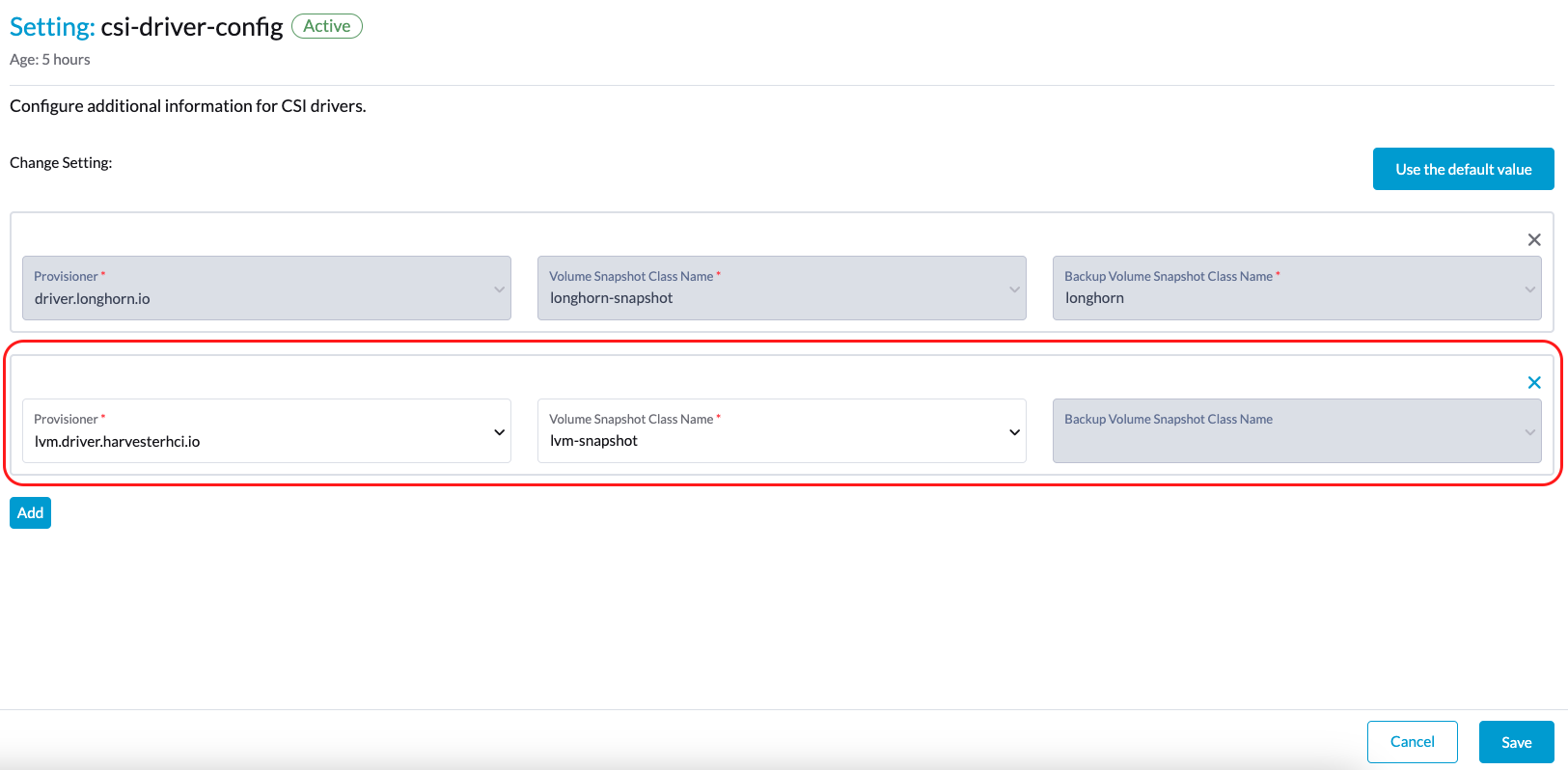
Use the CSI Driver
Once the CSI driver is installed and the Harvester cluster is configured, an external storage solution can be used in tasks that involve storage management.
Virtual Machine Image Creation
You can use an external storage solution to store and manage virtual machine images.
When uploading a virtual machine image using the Harvester UI (Image > Create), you must select the StorageClass for the external storage solution on the Storage tab. In the following example, the StorageClass is nfs-csi.
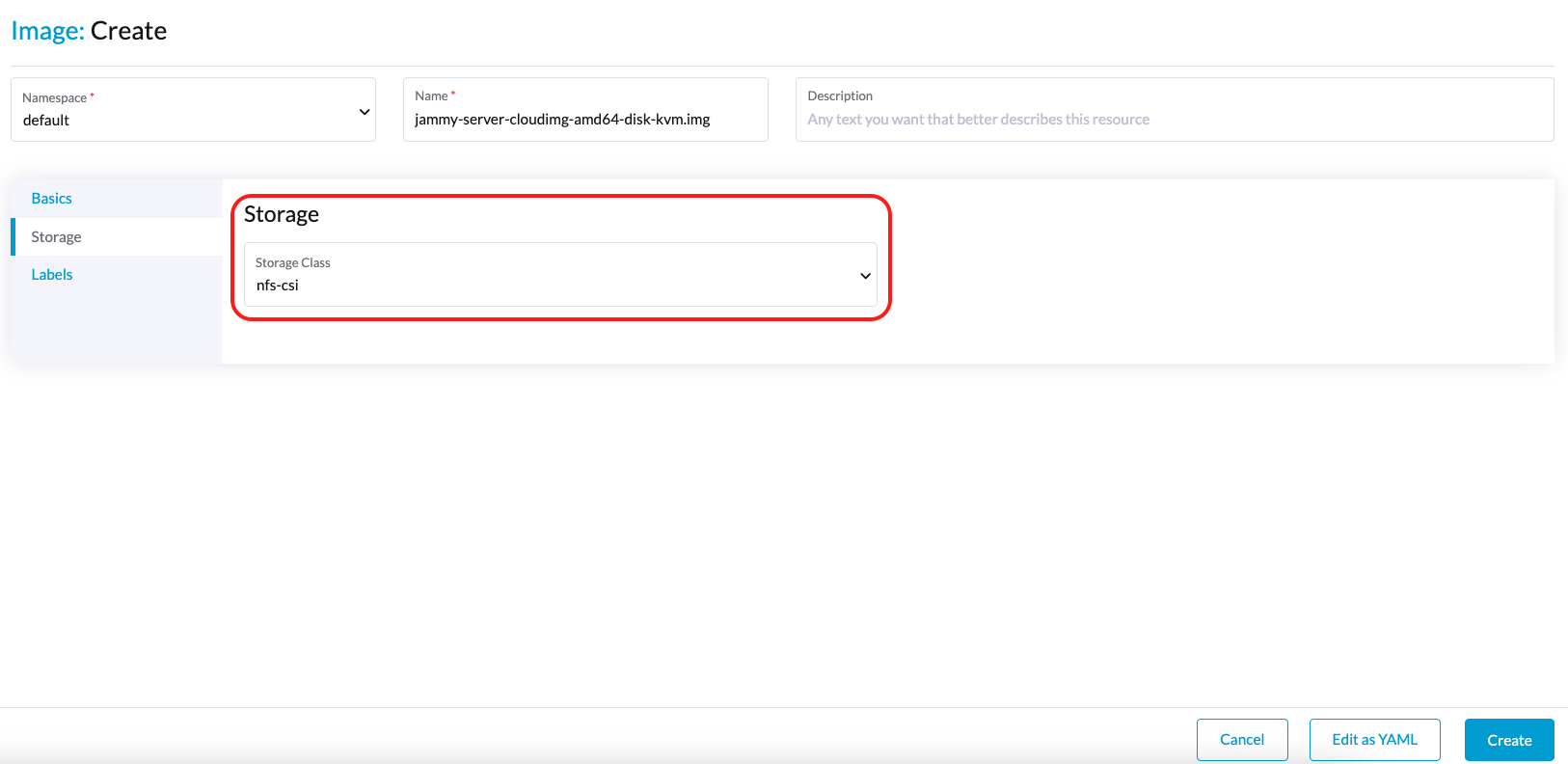
Harvester stores the created image in the external storage solution.
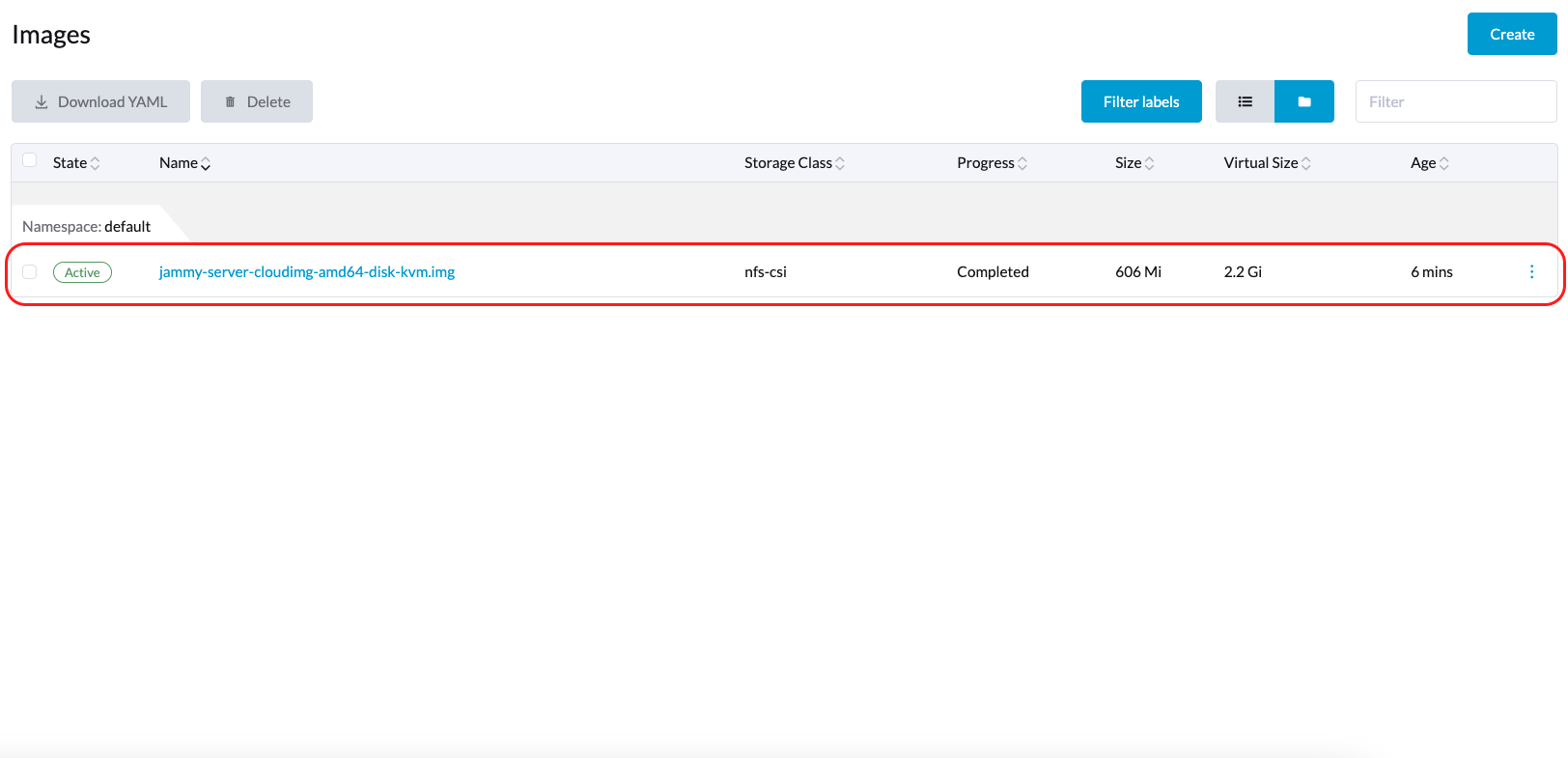
Virtual Machine Creation
Your virtual machines can use root and data volumes in external storage.
When creating a virtual machine using the Harvester UI (Virtual Machine > Create), you must perform the following actions on the Volumes tab:
- Select a virtual machine image stored in the external storage solution, and then configure the required settings.
- Add a data volume.
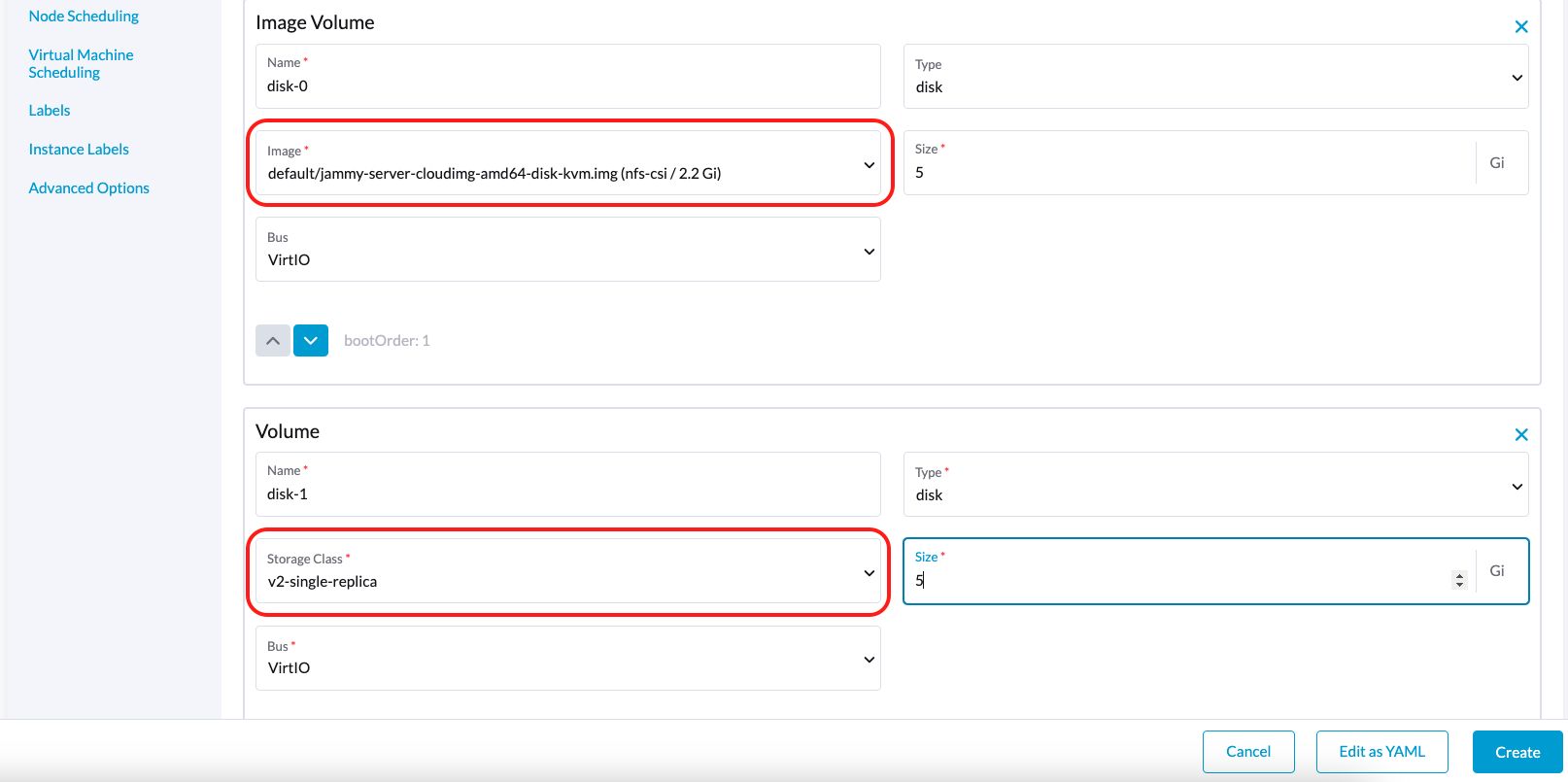
In the following example, the root volume is created using NFS, and the data volume is created using the Longhorn V2 Data Engine.

Volume Creation
You can create volumes in your external storage solution.
When creating a volume using the Harvester UI (Volumes > Create), you must perform the following actions:
- Storage Class: Select the target StorageClass, e.g. nfs-csi.
- Volume Mode: Select the corresponding volume mode, e.g. Filesystem for nfs-csi.

Advanced Topics
Storage Profiles
You can now use the CDI API to create custom storage profiles that simplify definition of data volumes. Storage profiles allow multiple data volumes to share the same provisioner settings.
The following is an example of an LVM storage profile:
apiVersion: cdi.kubevirt.io/v1beta1
kind: StorageProfile
metadata:
name: lvm-node-1-striped
spec:
claimPropertySets:
- accessModes:
- ReadWriteOnce
volumeMode: Block
status:
claimPropertySets:
- accessModes:
- ReadWriteOnce
volumeMode: Block
cloneStrategy: snapshot
dataImportCronSourceFormat: pvc
provisioner: lvm.driver.harvesterhci.io
snapshotClass: lvm-snapshot
storageClass: lvm-node-1-striped
For more information, see Storage Profiles in the CDI documentation.
You can define the above fields to override the default configuration showing on the status.
Avoid changing the storage profile or CDI directly. Instead, allow the Harvester controller to synchronize and persist the storage profile configuration through the use of CDI annotations.
Limitations
Backup support is currently limited to Longhorn V1 Data Engine volumes. Harvester is unable to create backups of volumes in external storage.
There is a limitation in the CDI which prevents Harvester from converting attached PVCs to virtual machine images. Before exporting a volume in external storage, ensure that the PVC is not attached to workloads. This prevents the resulting image from getting stuck in the Exporting state.
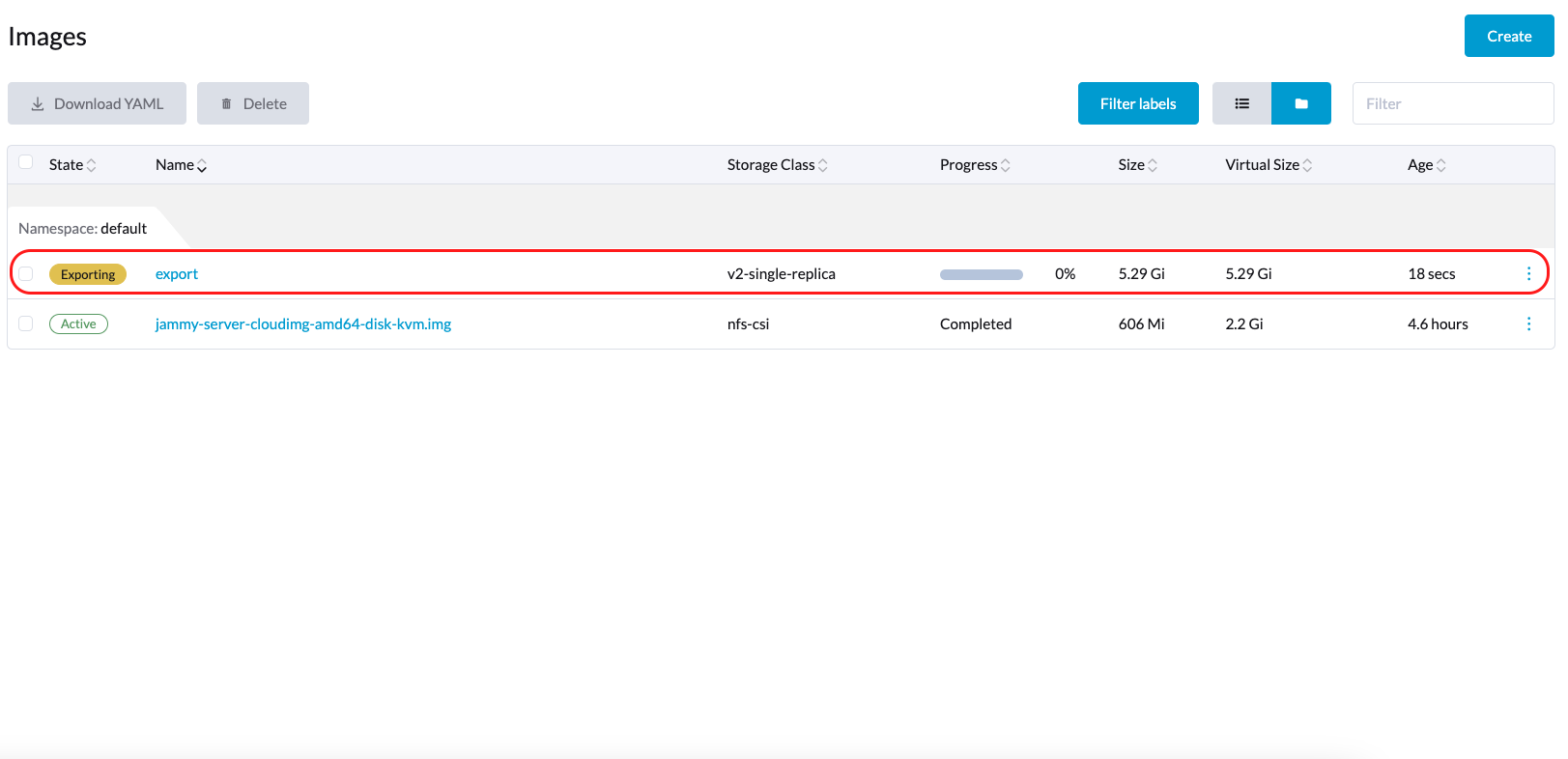
How to deploy the NFS CSI driver
You can deploy the NFS CSI driver only when the NFS server is already installed and running.
If the server is already running, check the squash option. You must disable squashing of remote root users (no_root_squash or no_all_squash) because KubeVirt needs the QEMU UID/GID to ensure that the volume can be synced properly.
Install the driver using the
csi-driver-nfsHelm chart.$ helm repo add csi-driver-nfs https://raw.githubusercontent.com/kubernetes-csi/csi-driver-nfs/master/charts
$ helm install csi-driver-nfs csi-driver-nfs/csi-driver-nfs --namespace kube-system --version v4.10.0Create the StorageClass for NFS.
For more information about parameters, see Driver Parameters: Storage Class Usage in the Kubernetes NFS CSI Driver documentation.
apiVersion: storage.k8s.io/v1
kind: StorageClass
metadata:
name: nfs-csi
provisioner: nfs.csi.k8s.io
parameters:
server: <your-nfs-server-ip>
share: <your-nfs-share>
# csi.storage.k8s.io/provisioner-secret is only needed for providing mountOptions in DeleteVolume
# csi.storage.k8s.io/provisioner-secret-name: "mount-options"
# csi.storage.k8s.io/provisioner-secret-namespace: "default"
reclaimPolicy: Delete
volumeBindingMode: Immediate
allowVolumeExpansion: true
mountOptions:
- nfsvers=4.2Once created, you can use the StorageClass to create virtual machine images, root volumes, and data volumes.
References
- Use Rook Ceph External Storage with Harvester
- Using NetApp Storage on Harvester
- Third Party Storage Support
Known Issues
1. Infinite Image Download Loop
The image download process loops endlessly when the StorageClass for the image uses the LVM CSI driver. This issue is related to the scratch volume, which is created by CDI and is used to temporarily store the image data. When the issue exists in your environment, you might find the following error messages in importer-prime-xxx pod logs:
E0418 01:59:51.843459 1 util.go:98] Unable to write file from dataReader: write /scratch/tmpimage: no space left on device
E0418 01:59:51.861235 1 data-processor.go:243] write /scratch/tmpimage: no space left on device
unable to write to file
kubevirt.io/containerized-data-importer/pkg/importer.streamDataToFile
/home/abuild/rpmbuild/BUILD/go/src/kubevirt.io/containerized-data-importer/pkg/importer/util.go:101
kubevirt.io/containerized-data-importer/pkg/importer.(*HTTPDataSource).Transfer
/home/abuild/rpmbuild/BUILD/go/src/kubevirt.io/containerized-data-importer/pkg/importer/http-datasource.go:162
kubevirt.io/containerized-data-importer/pkg/importer.(*DataProcessor).initDefaultPhases.func2
/home/abuild/rpmbuild/BUILD/go/src/kubevirt.io/containerized-data-importer/pkg/importer/data-processor.go:173
kubevirt.io/containerized-data-importer/pkg/importer.(*DataProcessor).ProcessDataWithPause
/home/abuild/rpmbuild/BUILD/go/src/kubevirt.io/containerized-data-importer/pkg/importer/data-processor.go:240
kubevirt.io/containerized-data-importer/pkg/importer.(*DataProcessor).ProcessData
/home/abuild/rpmbuild/BUILD/go/src/kubevirt.io/containerized-data-importer/pkg/importer/data-processor.go:149
main.handleImport
/home/abuild/rpmbuild/BUILD/go/src/kubevirt.io/containerized-data-importer/cmd/cdi-importer/importer.go:188
main.main
/home/abuild/rpmbuild/BUILD/go/src/kubevirt.io/containerized-data-importer/cmd/cdi-importer/importer.go:148
runtime.main
The message no space left on device indicates that the filesystem created using the scratch volume is not enough to store the image data. CDI creates the scratch volume based on the size of the target volume, but some space is lost to filesystem overhead. The default overhead value is 0.055 (equivalent to 5.5%), which is sufficient in most cases. However, if the image size is less than 1 GB and its virtual size is very close to the image size, the default overhead is likely to be insufficient.
The workaround is to increase the filesystem overhead to 20% using the following command:
# kubectl patch cdi cdi --type=merge -p '{"spec":{"config":{"filesystemOverhead":{"global":"0.2"}}}}'
The image should be downloaded once the filesystem overhead is increased.
Increasing the overhead value does not affect the image PVC size. The scratch volume is deleted after the image is imported.
Related issue: #7993 (See this comment.)
2. Multipath support
Available as of v1.4.3
Certain 3rd party CSI may need multipath to be enabled.
By default multipathd is disabled in Harvester. Users can enable this post installation by simply logging into the individual nodes and running the following commands:
systemctl enable multipathd
systemctl start multipathd
This can also be executed by dropping an elemental cloud-init file such as /oem/99-start-multipathd.yaml with the following contents
stages:
default:
- name: "start multipathd"
systemctl:
enable:
- multipathd
start:
- multipathd
Users wishing to automate this further can leverage the CloudInit CRD to apply the same instructions to a set of hosts
apiVersion: node.harvesterhci.io/v1beta1
kind: CloudInit
metadata:
name: start-mutlitpathd
spec:
matchSelector:
harvesterhci.io/managed: "true"
filename: 99-start-mutlitpathd
contents: |
stages:
default:
- name: "start multipathd"
systemctl:
enable:
- multipathd
start:
- multipathd
paused: false